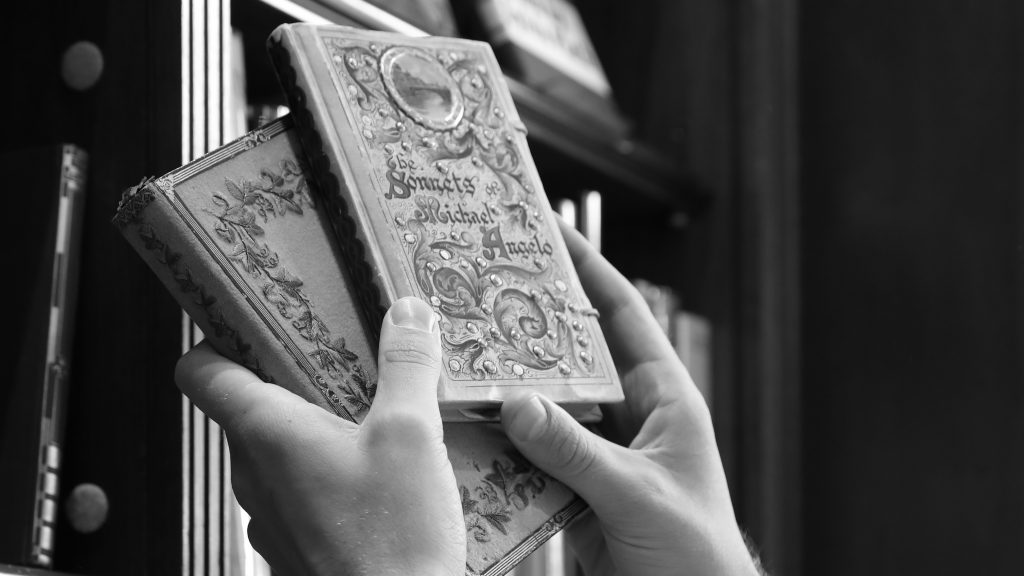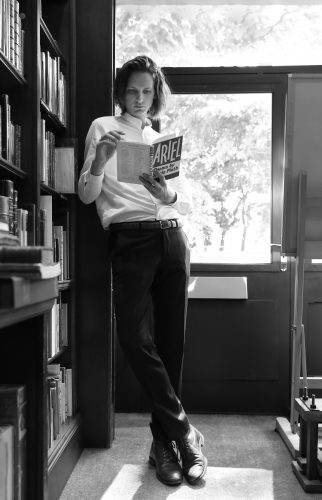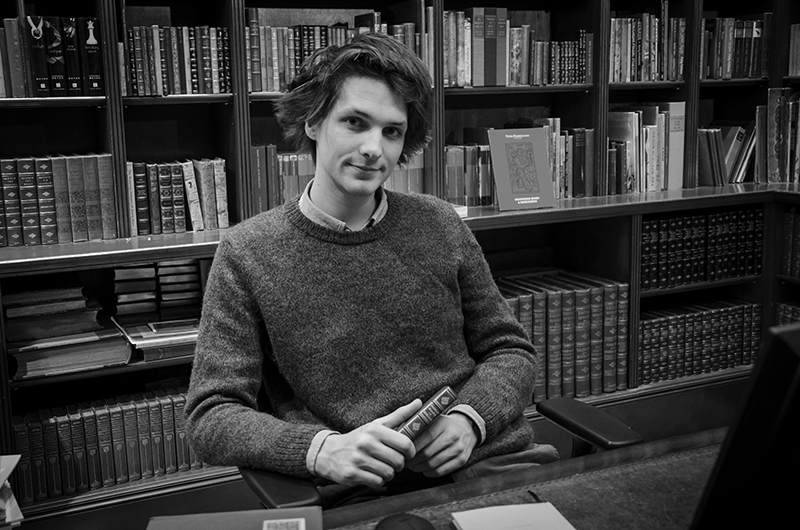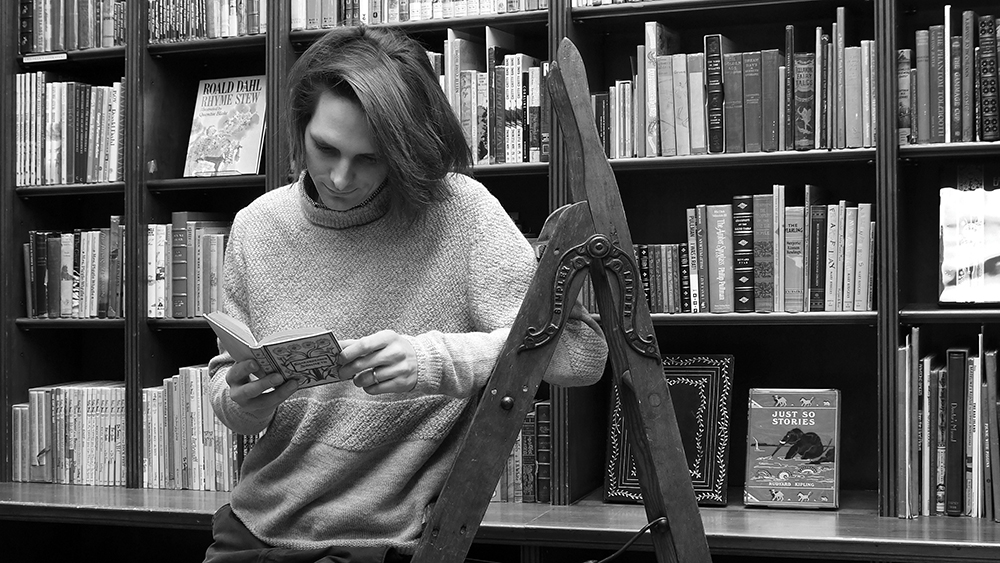Interview by Lauren Hepburn.
How did you come to the rare book trade, and how have your responsibilities evolved in that time?
My “origin story” is a bit crazy. About a decade ago, after tumbling out of my English Literature degree without much direction, I found a book on the bookshelves in my grandfather’s house that changed my life.
I was looking through his library after he died, getting a sense of what he cared about (there was a lot of Romantic poetry, a connection I didn’t know we had – he was an economist), and on the top shelf, untouched and unnoticed for decades, was a first edition of Frankenstein, inscribed by Mary Shelley to Byron. Needless to say, this was a very significant and valuable book. My grandmother decided that it should continue its story, and be sold.
That was how I encountered the rare book trade: the discovery opened the door to a whole world which I barely knew existed, peopled with dealers, collectors, and curators whose enthusiasm for all the things I cared about was what sustained them. So I jumped in with both feet and, after they handled the sale of Byron’s copy of Frankenstein in the spring of 2012, started working at Peter Harrington.
Since then, I’ve worked at most aspects of the trade: packing and polishing in the post room, cataloguing mountains of books, holding the front line with the sales team during our Dover Street shop’s Christmas rush, tending the stand at book fairs in London and abroad and, in more recent years, moving into the buying side of things.
Tell us about your current role at Peter Harrington.
I look after the Modern Literature at Peter Harrington – though “modern” is a loose term, and my enthusiasm for Poetry in particular often has me reaching further into the past. Really, my passion is for literature in general, any feat of human imagination in word form. Essentially, if it didn’t happen, I’m interested.
What this entails is a lot of buying – my main activity is scouring the globe in search of great books to fill our shelves, mostly through the internet these days, but we look forward to the return of book fairs and road trips. We have two shops to fill, and many ravenous customers, so I’m busy. But I absolutely love it. Making house calls is something I particularly cherish – seeing books in their “natural habitat” and helping people uncover the rarities is a delight, not least because you get to meet such lovely and interesting people. I work with our team of cataloguers to process what comes in. They’re always surprising me with their own discoveries and interpretations.

Relationships with customers is also a big part of what I do; finding the right home for any given book is really rewarding. After almost a decade, many customers are by now old friends – I enjoy keeping them up to date about anything that might come in “with their name on it”, as it were, and it’s a pleasure to have some involvement in how their collections grow and develop – witnessing the unfolding of whatever story they’re trying to tell.
You have responsibilities both buying and sell books, as well as curating catalogues – how do these roles intersect?
Every year the process of buying culminates in a printed catalogue or two from the literature side. I set the theme for these and curate the selection, which I find personally extremely involving, and which sometimes presents an opportunity to reflect on current events. For example, last year’s Fantasy & Science Fiction catalogue came out during the dystopian nightmare of the first lockdown, and stories like E. M. Forster’s The Machine Stops took on a renewed relevance. It’s very energising to me, the way in which all these treasures of the past can still speak to us today. It’s like T. S. Eliot said: “the historical sense involves a perception, not only of the pastness of the past, but of its presence”.
So I suppose when I’m out buying I’m often, consciously or subconsciously, thinking about the next catalogue, as well as looking out for specific rarities which customers have asked us to hunt down. There’s an imaginary wall of “Wanted” posters in my head – and when you encounter one at a book fair it’s a question of shoot on sight!

Tell us about one of your weirdest and most wonderful experiences working with Peter Harrington.
I had a wonderfully bizarre half hour when a man walked in and sat down asking me whether we had any books “about either Richard II, or Abraham Lincoln”. “Two very specific and not obviously related people”, I replied, “What connects your interest?” At which he grinned widely and revealed to me that he was in fact the reincarnated person of them both.
I think of this whenever people ask me “why do people collect books?” There are so many varied reasons! Plus, if anyone asks who the biggest celebrity we’ve ever had in the shop, I know my answer – Abraham Lincoln.
The travel side of my work can also take me to unexpected places – there was a brief trip to Hawaii where we bought a huge collection of Hawaiiana, and we were woken each morning by a dawn chorus that sounded extra-terrestrial to ears used only to the cooing of London pigeons.
What do you think the role of book dealers is in preserving items of historical significance?
It’s a good question – sometimes we do get people seeing the things we have and saying, “but that should be in a museum!” I would challenge the assumption that items being in private hands is in some way inimical to their preservation or even, necessarily, their accessibility. Byron’s Frankenstein, for example, was purchased by a British private collector, but they have several times allowed it to be included in public exhibitions around the world.
Dealers working with collectors play their part in recognising (and thereby raising) the value of books and manuscripts, which has the knock-on effect of making their owners more careful with them. The number of books which we spend significant money preserving with judicious repair work, or for which customers order fire-proof solander boxes from our Chelsea Bindery, is worth remembering, too.

It’s a sad thought but if these sorts of books weren’t worth money, many would end up in the skip. As it is, however, people who discover interesting items at home bring them to us, and we set to work finding appreciative new custodians for them. I hope that arrangement is good for everybody, including the books.
We do have great relationships with various libraries and museums too, and when we find something that really should be in a particular institutional collection, we do what we can to facilitate that.
You recently helped curate an exhibition to accompany a Fendi fashion show – can you tell us how this came about and what your contribution was?
Yes, it was very exciting – and unexpected! The connection to Fendi came through their Artistic Director of Couture and Womenswear, Kim Jones, who is himself a great collector of books. During the pandemic we enjoyed chatting about books together, and one of his great passions is Virginia Woolf and the Bloomsbury Group. When it came to his debut couture collection last January, he themed it around Orlando and the great love story between Virginia Woolf and Vita Sackville-West, and he asked me to help curate an exhibition of books and manuscripts from his personal collection in a side-room at the show. It was a thrill to see rare books thrust into this kind of limelight – the video for the show stars Demi Moore gingerly leafing through the first edition of Orlando which Woolf inscribed to Sackville-West. It was also very gratifying to see how collecting can be a creative process: old creations giving inspiration to new.
What projects are you currently working on?
We’re right now putting out our latest catalogue on the broad theme of “Poetry”. It’s a question of coming full circle for me, as that was the subject of my very first catalogue for Peter Harrington, five years ago. There’s some incredible things in there – our first edition of Walt Whitman’s Leaves of Grass (which I dearly love) has promotional broadsides stuck in by the poet himself, and holding it gives me full-blown ASMR. It was one of the very first copies ever to cross the Atlantic for a British readership, being a promotional copy sent to the editor of the Edinburgh Review.
If you could have any book in Peter Harrington’s collection for yourself, what would it be?
There are long-since-sold books which I sometimes remember with a pang – we had a copy of the Rubaiyat which Dylan Thomas owned as a drunken teenager, or Aubrey Beardsley’s own copy of Malory’s Morte D’Arthur, owned before he started work on his illustrated edition, with a drawing of Merlin in the front. Those sorts of things set my imagination on fire.
But right now, the book that blows my mind is actually the 1488 first edition in Greek of Homer’s Iliad and Odyssey, printed at the height of the Florentine Renaissance, before the French war and Savonarola turned things sour for anyone fond of poetry or pagans. For me, it marks an exciting moment in history when two unrelated forces met: the technology of printing (introduced in Europe only three decades earlier) travelling south into Italy from Germany and encountering waves of Greek scholars moving west after the sack of Constantinople, bringing with them their language, their learning, and their manuscripts.
I don’t know where I’d put it, though – the two huge folio volumes bound in bright red leather would look rather out of place in my flat. Still, I wouldn’t say no!
Sammy’s Picks
LE GUIN, Ursula K. The Left Hand of Darkness. £1250.
WHITMAN, Walt. Leaves of Grass. £295000.
This rare English issue of the first edition of Leaves of Grass was one of the first copies ever to cross the Atlantic for a British readership, being a promotional copy sent to the editor of the Edinburgh Review – the literary scene of the Old Country was hardly ready for Whitman’s “barbaric yawp”. What really moves me (aside from the poem) are the broadsides stuck in by the poet himself, touting his own brilliance.
THOMAS, Dylan. Selections from his Writings Read by the Poet – Volume I. £2750.
This record has Dylan Thomas mischievously inscribing “my name rhymes with villain!” for a fan in New York, while he was on his alcoholic downward spiral. Recordings like this that capture of the voice of the poet are so valuable for posterity, and I could listen to him reading, or rather incantating, “Fern Hill” anytime.
SHELLEY, Percy Bysshe. Adonais. £1500.
This is edition of Shelley’s eulogy for Keats, which was really a pre-emptive eulogy for himself, is in a lovely little Arts & Crafts binding. Also: “Life, like a dome of many coloured glass, / stains the white radiance of eternity” – I’m still unpacking that
SAPPHO; WHARTON, Henry Thornton (trans.) Memoir, Text, Selected Renderings. £675.
This scarce edition marked an important moment in making Sappho – the idea of her as well as the few gleaming fragments that remain of her poetry – accessible to the general English reader. Wharton prints the original Greek alongside his own literal translation, and selects from several prior poetic interpretations. If you care about poetry of any kind, having a sense of Sappho is essential – she was the original poet.
OLIVER, Mary. Twelve Moons. £750.
Mary Oliver has been a constant companion over the past few years, and I have been enjoying watching her growing in popularity, particularly in the rare book market! This is early collection is scarce and has some great poems – try “The Night Traveller”.
KEROUAC, Jack. On the Road. £3250.
On the Road is a book I love. I took my own cross-country American road trip at the age of 22, in pursuit of the myth Kerouac conjured up in these pages – seeing this volume on the shelf always brings back memories.
FROST, Robert. Mountain Interval. £3750.
This copy has a really meaningful inscription. Mountain Interval has Frost’s famous poem “The Road Not Taken” in it, a meditation on the fork-in-the-road decision taken by his friend the poet Edward Thomas, who chose to go to the front (where he was soon killed), versus Frost’s own decision to return to America from England at the outset of the war, and take up a teaching position at Amherst College. This copy was inscribed by Frost to one of his Amherst students, who then chose to sign up and go to fight in Europe, and so many Americans did. I wonder what Frost thought – did his student read “The Road Not Taken” correctly?
COHEN, Ira (ed.) Gnaoua. £2250.
This scarce little one-shot Beat magazine from Tangiers was one of several hipness-heightening nick-nacks artfully strewn around for the cover photograph of Bob Dylan’s album Bringing It All Back Home. You can see it on the mantelpiece!





